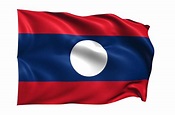
Considering that I have been up for a substantial number of hours from the morning’s first blush, the mood is sparkling. First an early breakfast overlooking the Mekong from Nam Khong Riverside café on the Thai side of the border. So early that the sun still reflects orange in the river.
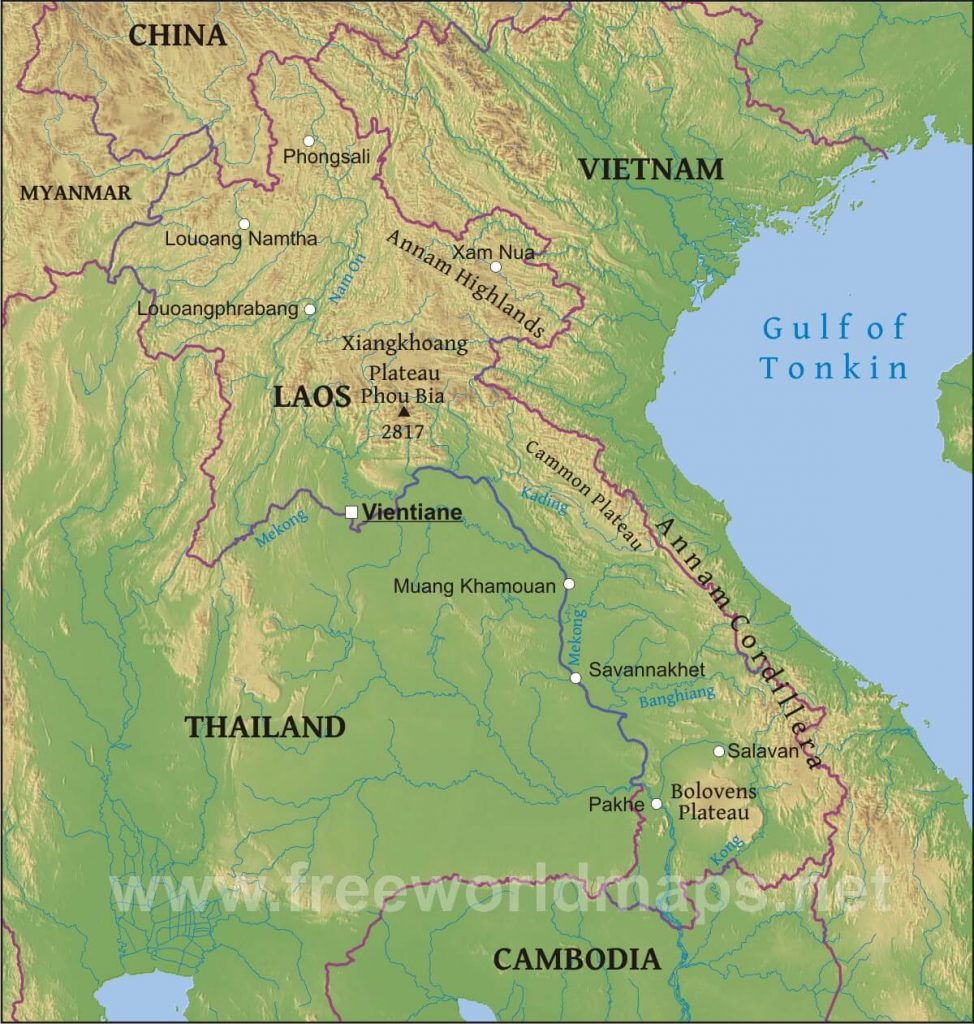
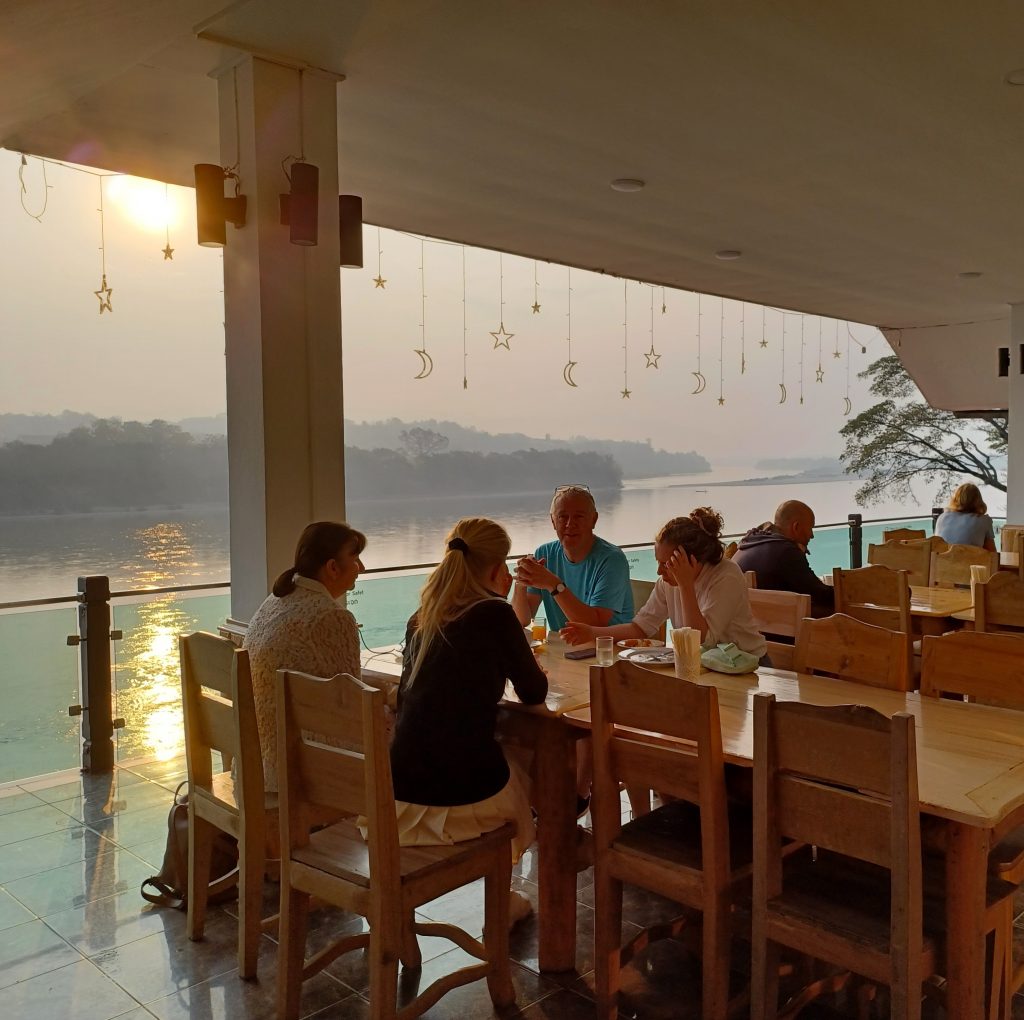
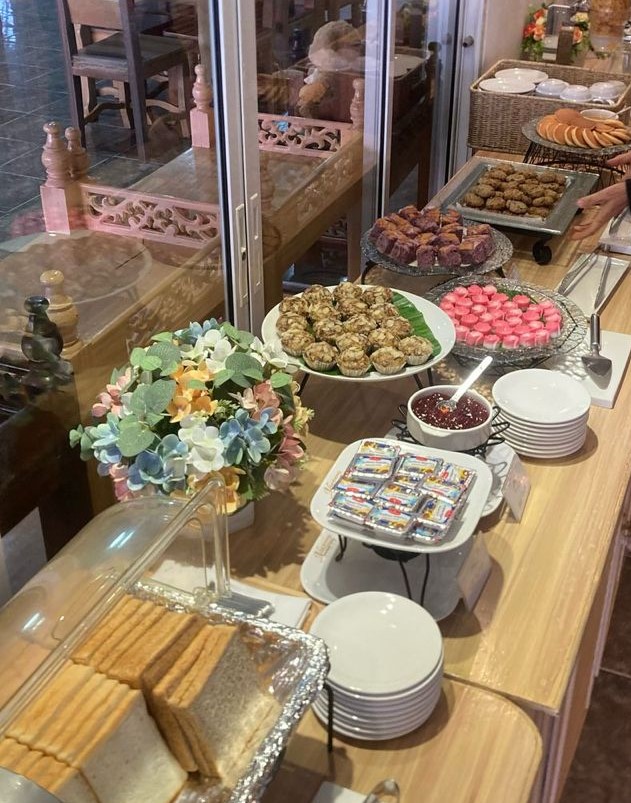
Having spent much time breakfasting, we arrive at the Thai-Lao border later than most tourist buses and the earlier lengthy queues have dissipated. How lucky is that. Had been told by the tour company that I should purchase a Lao visa at the border. Only two of us had gone down this route, the others preferring not to chance it, I suppose, and acquired theirs in advance. But we two are first through immigration. And soon all other passports are checked and stamped and we’re in Laos. Thence to be bussed over the Fourth Thai-Lao Friendship Bridge to Houayxay and the banks of the Mekong River.
The Mekong river flows north-south through Laos, beginning its journey in China, into Burma, Laos, Thailand, Cambodia and Vietnam, and finishing up in the Mekong Delta in Vietnam. ‘Mekong’ or ‘Mae Nam Khong’ means Big River Khong. ‘Nam’; means river in Lao and the river forms over half of the border between Thailand and Laos. The broad brown Mekong runs swiftly through the hills and here we board our boat, our home for the next two days, but not nights. Sublime.
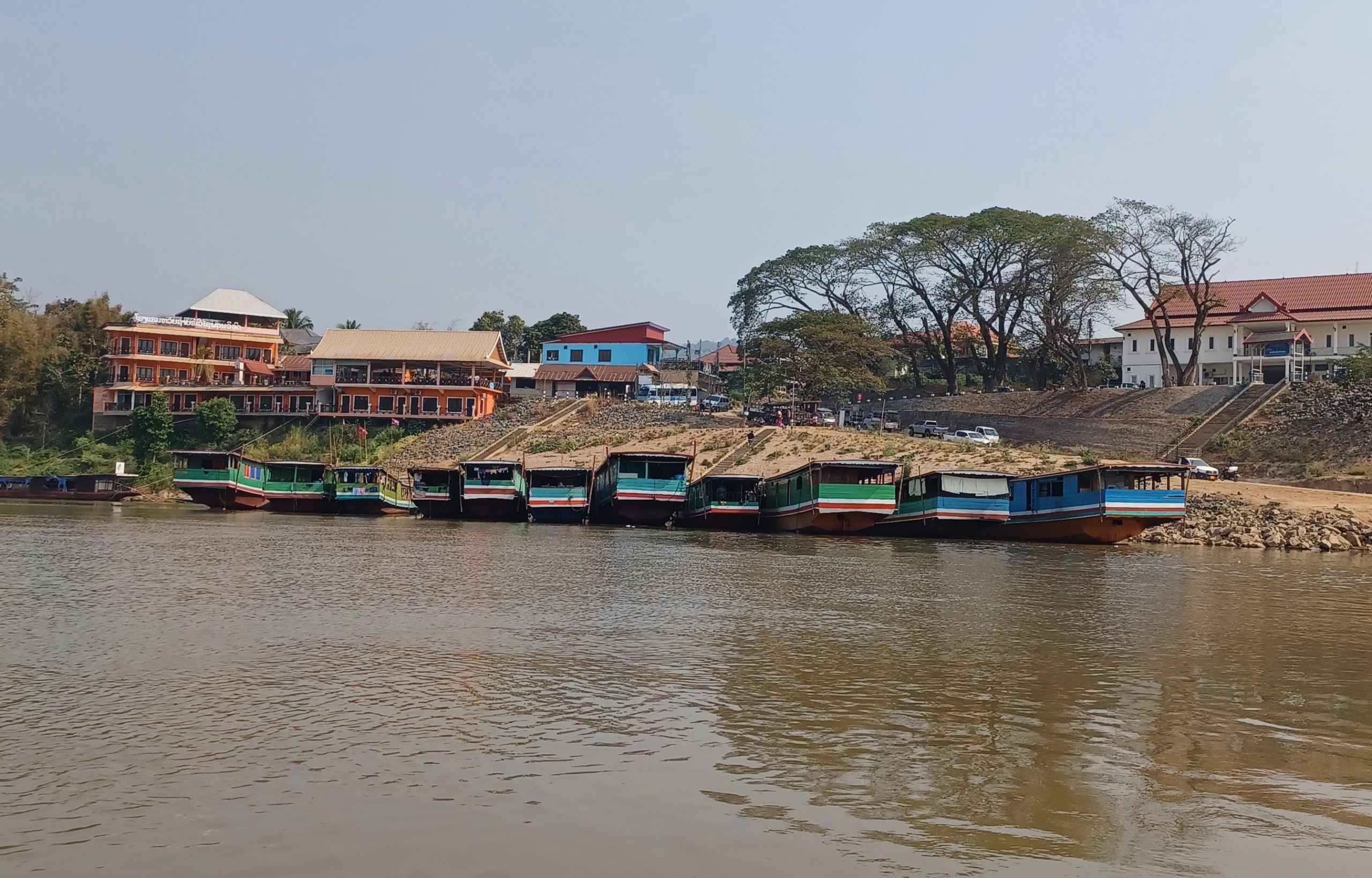
Am looking forward with happy anticipation to this voyage. Golden Buddhas and temples are all splendid to see of course. We have seen a great many of them in Thailand and will be seeing countless more in Laos. But now for some spiritual encounters with Mother Nature instead. Something a little less glittering gold. More pastel natural shades. A slow boat heading downstream through the hills of Laos. I think of home for a second and the yearning I often experience to escape the damp English winter. Rudyard Kipling, voicing the thoughts of a soldier stuck in London with a girl in Mandalay, Burma, not far from here, put it thus in his poem ‘Mandalay’:
‘…I am sick o’ wastin’ leather on these gritty pavin’-stones,
An’ the blasted Henglish drizzle wakes the fever in my bones…’
Serene and warm here. February. Anyway, it is a biggish boat, 39 meters long and about three metres wide. It draws 70 centimetres, I am told, so not much. Just as well, as we do not want to touch bottom in some of the shallower sections of the Mekong. There is a large space on the foredeck for some to sunbathe on sunbeds or sit in the shade of the awning. Midships and inside is an area of wooden tables and seats, with pinkish cushions, for lunches and snacks. And aft is more space for viewing the river.
We have our own guide or CEO (Chief Experience Officer) for the duration of the tour. He had already introduced himself while in Thailand with a longish monologue. Enthusiastic and well-meaning sort of chap with a squarish face and wearing a bush hat. More of an organiser and trouble shooter than a guide. Turns out that local guides are also on hand at every stage of the tour. The one we have now had met us at the border and gives us a bit of a pep talk. Especially about the important things, which we all remember, such as timings for lunch. There are large flasks of hot water, he points out, from which we can help ourselves to make tea or coffee, and plates of fruit, from which we can cherry pick. Jolly good.
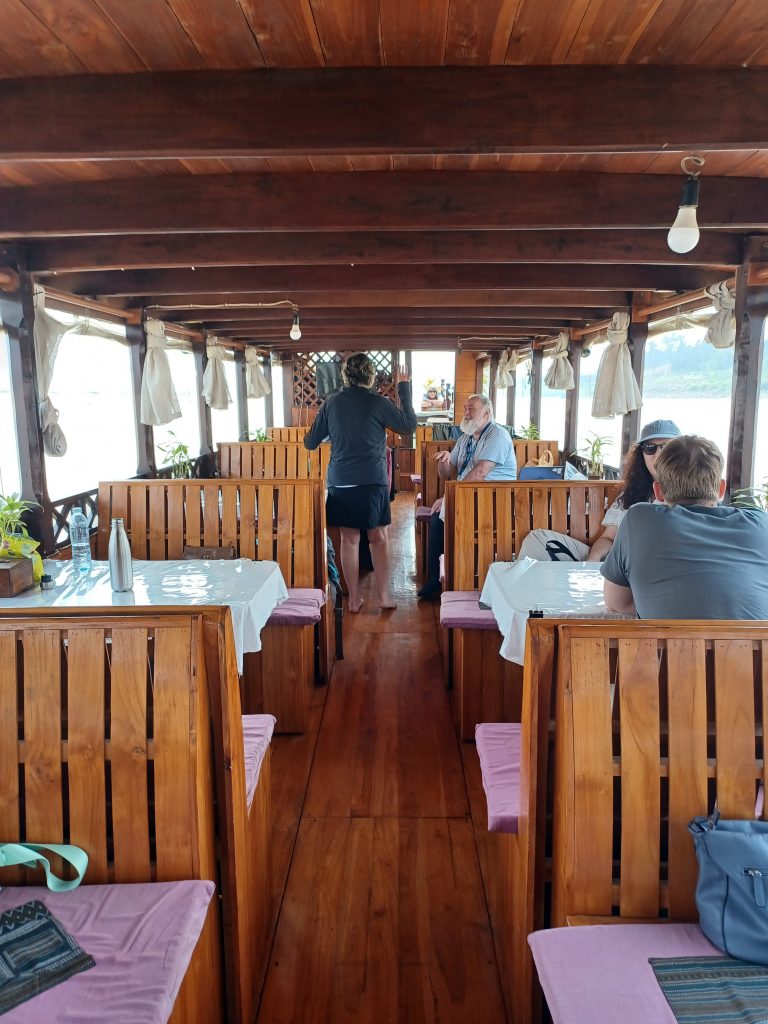
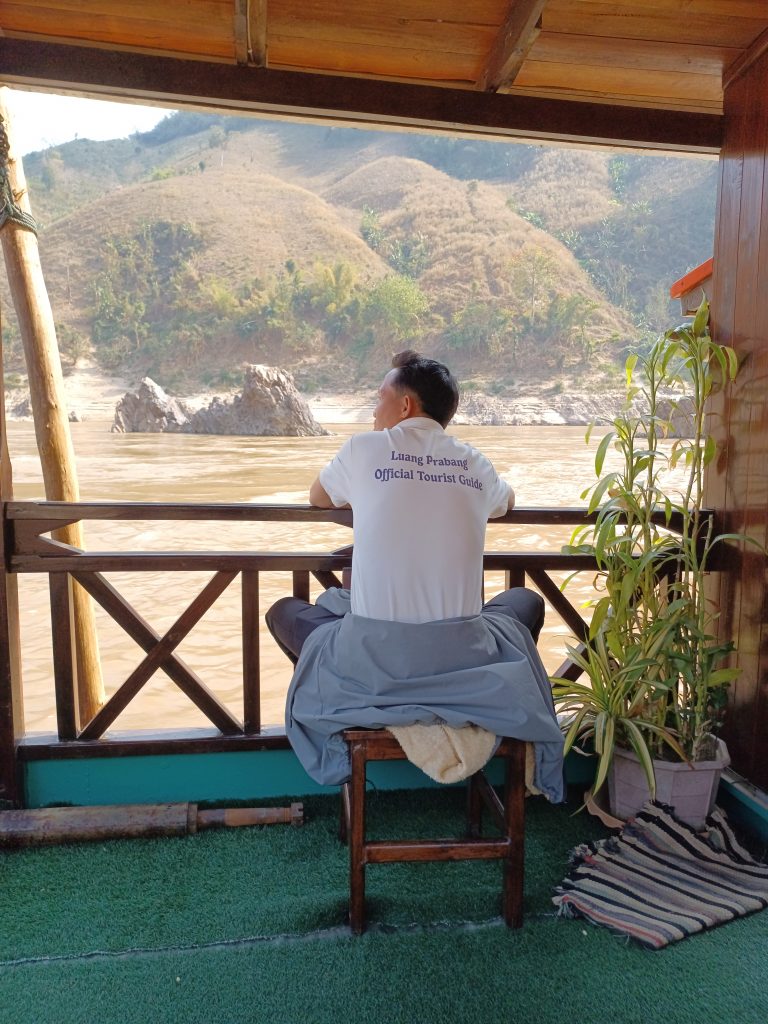
Cast off and off we go. Fishing lines on bamboo poles poke out from the rocks, panners are panning for gold. We shoot through narrow straits between the rocks, the captain steering between them with some skill. Good job. Not sure if there are life jackets on board or other safety features. Don’t let such thoughts bother me. Forest covered slopes, oxen on beaches, footsteps on the sand come and go. And a lone elephant. I scour the banks with my binoculars. Not many birds to be seen. Only the odd egret and a brown heron so far.
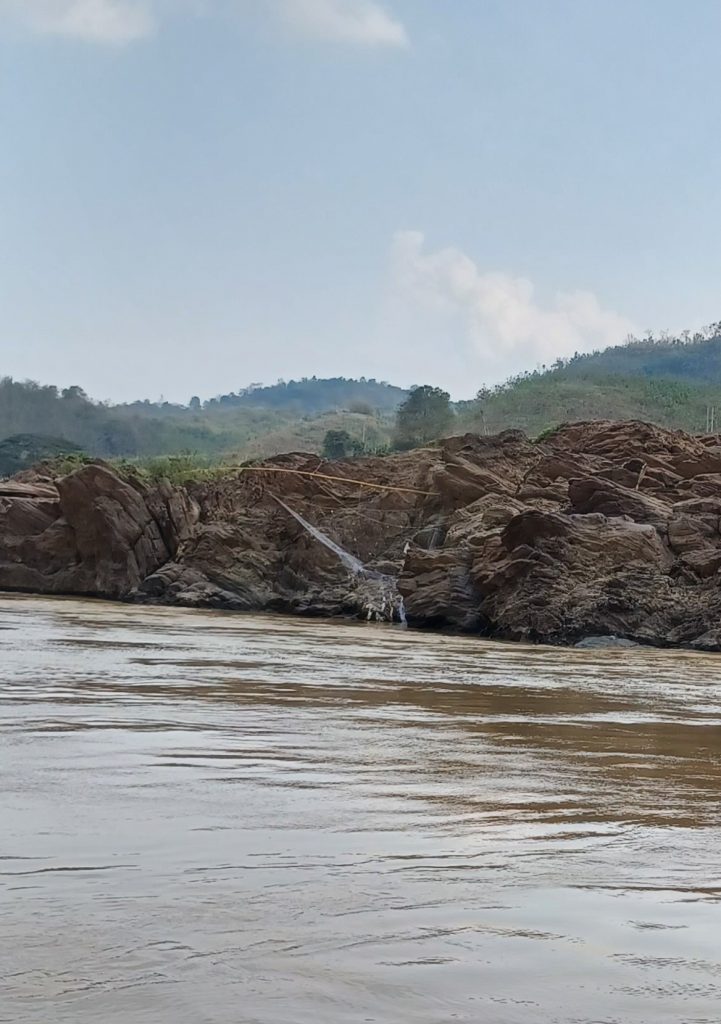
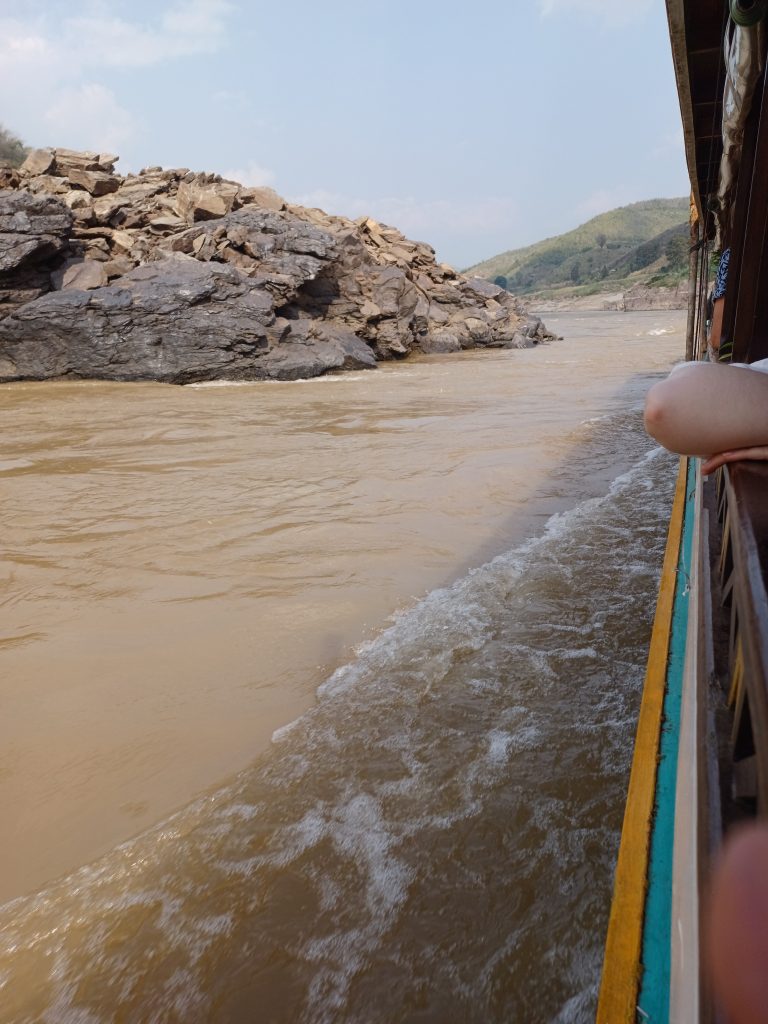
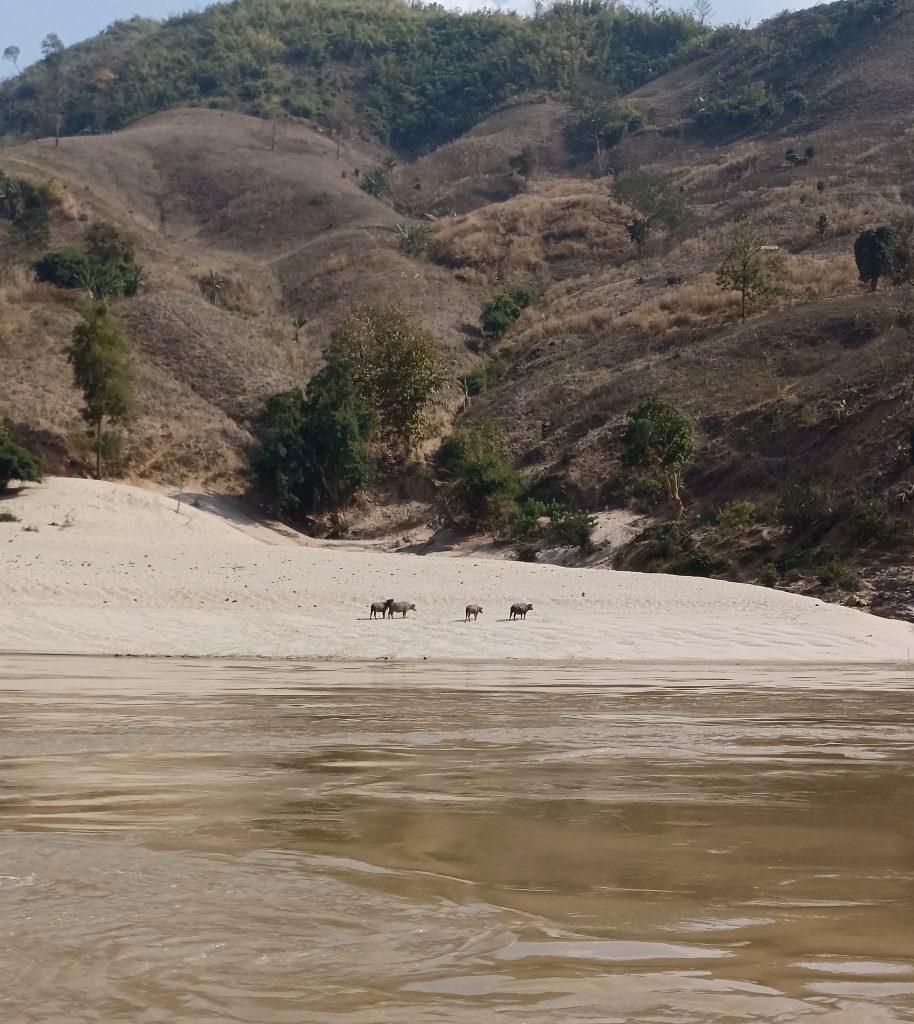
High up, we see pylons and cables running along an invisible track through the forest. And two rows of white houses on stilts stand out from the foliage. Fast stripy boats with long tiller extensions zip along. Some boats are moored up and large dredgers are digging for gold. We are told that large companies need a license to dig, although individuals don’t need one. We see some of the latter with their big pans and a small sluice worked by two or three men and women, while the big machinery operated by the large companies squats on the water. “They needed the gold to cover their Buddhas”, the guide tells us. That figures. We float under a long bridge with concrete supports and iron struts atop. Reminds me of the Kwai Bridge (see Thailand, Part 2: Bridge over the River Kwai).
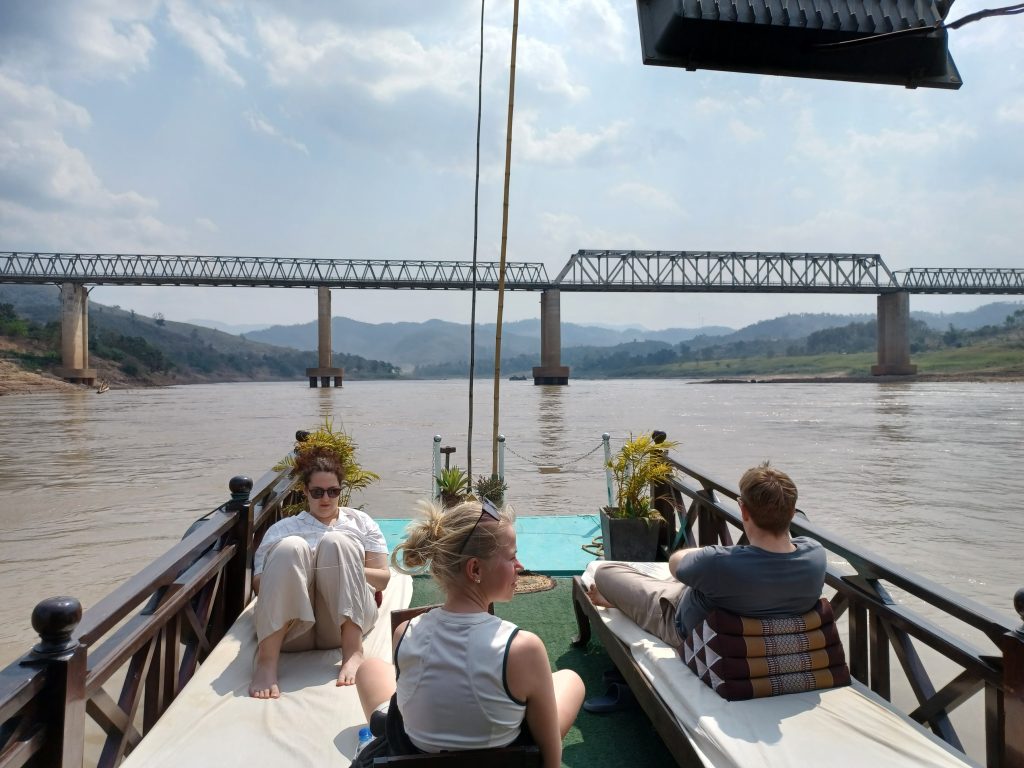
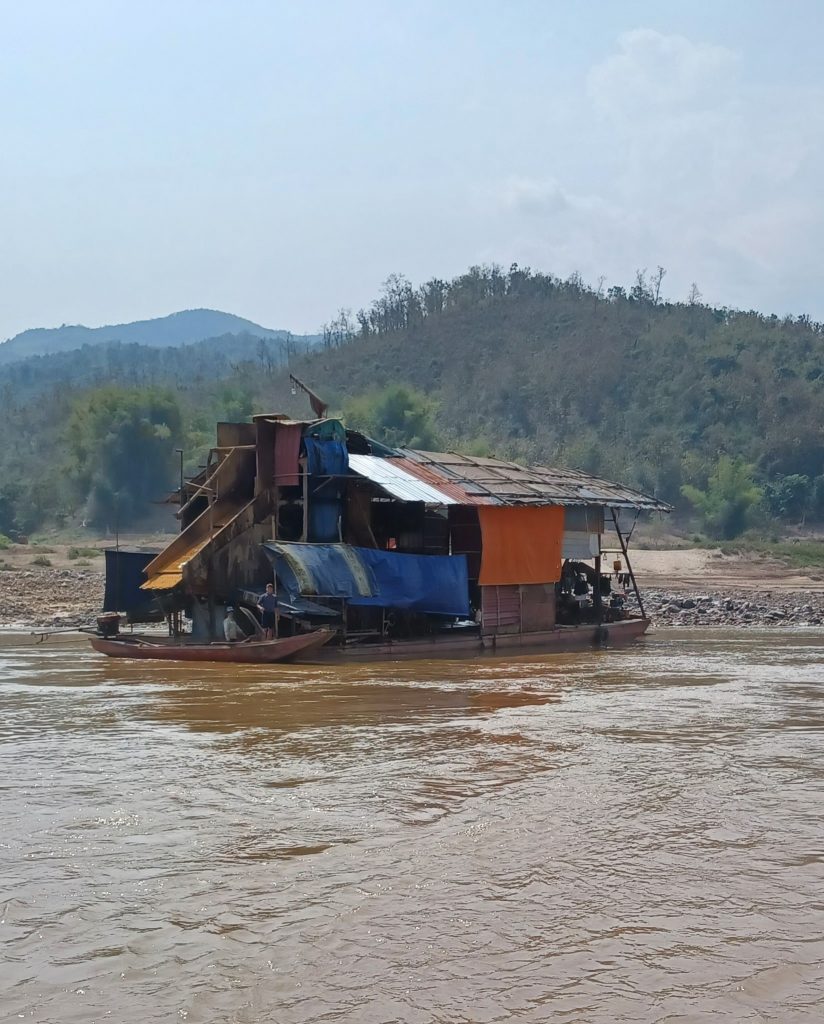
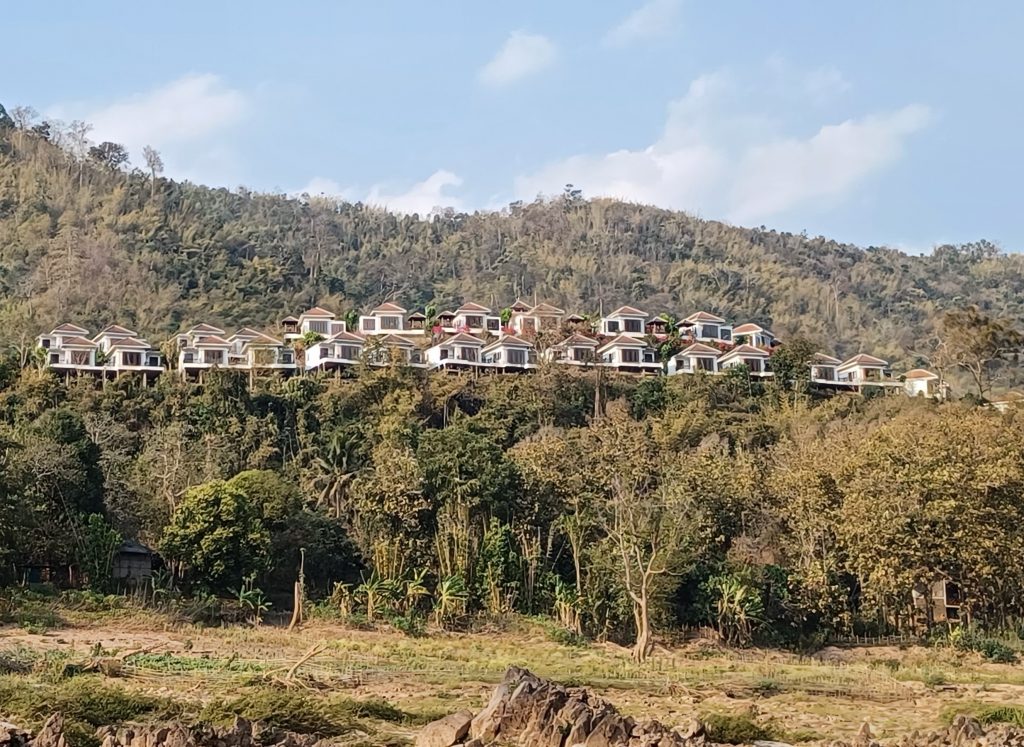
Swirling eddies all along and a very strong current. Reckon we could be travelling at ten knots with the current. It must take some power to motor in the opposite direction, i.e. upstream, I muse. There are no really large boats. It would be difficult for them to navigate the narrow passes. We are told that the water level is much lower than it should be and the guide points to the usual water line, seen on the rocks, which is two metres higher up. “The Chinese are building a dam upstream” he says, “and this is affecting the water level”. I was told this when exploring the Mekong delta in Vietnam ten years or so ago. Maybe this is another dam.
Ban Huay Thom Village
We are due to stay tonight in a village of the Khmu people named Ban Huay Thom. Thus, late afternoon, we disembark from our ‘slow’ boat onto a broad sandy area. Men lay gang planks to aid our descent. Little kids hover.
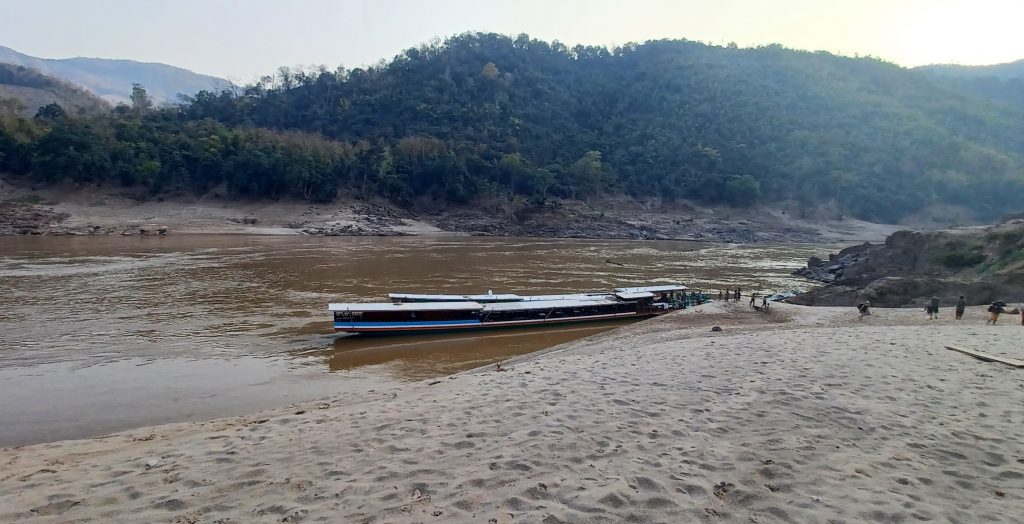
We flounder up through the sand to a village of wooden houses and a larger central community hut. The latter is where we will congregate for meals. Head further into the village to explore via cracked mud pathways between houses on stilts. Eco-friendly with stupendous views.
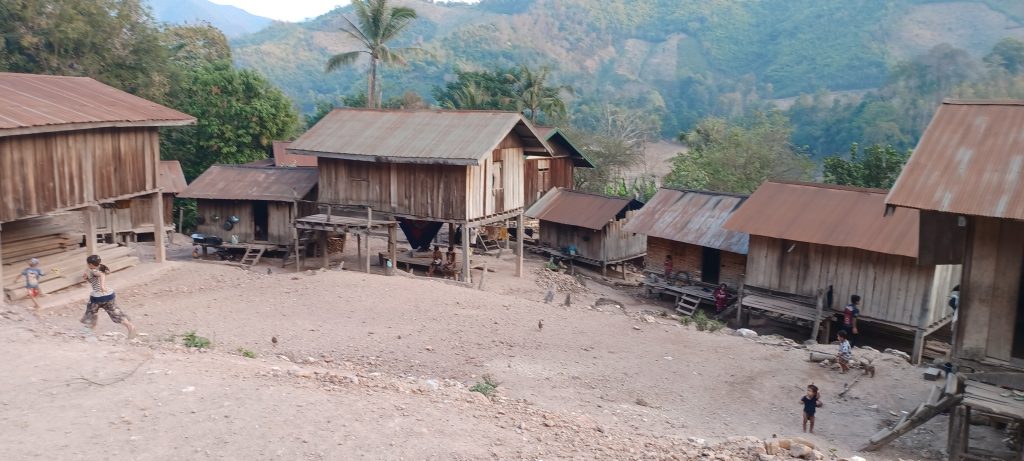
The three fitter younger ladies amongst us are to occupy a house higher up the slope, three couples in another and six older, less fit perhaps, ladies and gents are lodged closer to the community hut. There are toilets in separate wooden huts each shared between two houses. These were built by the tour company apparently. Within the toilet huts are large barrels of water from which to scoop water to flush. Some of our party are rather aghast at the conditions in the village. Way out of their comfort zone. Some grumbling to our CEO. “But this is all part of it!” proclaims he. “A great adventure. This is what we travel for!” Much to be said for that. I mean, we are seeing how the locals live. Different culture, different circumstances. Not the rich west. I have seen far worse.
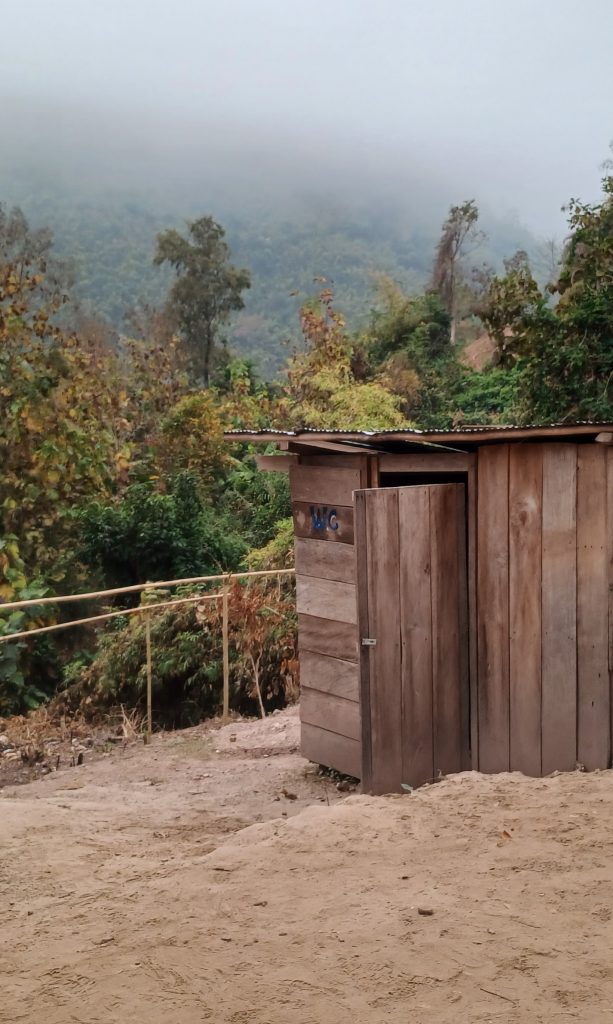
Supper in the big hut, served by the local people: rice and noodles, fried vegetables with grated chicken and pork morsels on lemon grass sticks. Water melon completes the feast. Plenty of water.
Girls perform a show afterwards for the two tour groups that are here assembled. First a local dance in which the girls, in traditional dress, dance rhythmically to a drum beat. This is followed by a ‘bamboo dance’. We are encouraged to participate. I suppose one ought to fling oneself into the spirit of the thing. But I prefer to watch others get their ankles bashed by bamboo, when they get the rhythm wrong. The trick is to hop over the bamboo poles as the girls move them from side to side. The girls themselves are adept at this dance. Lot of practice no doubt. Much applause.
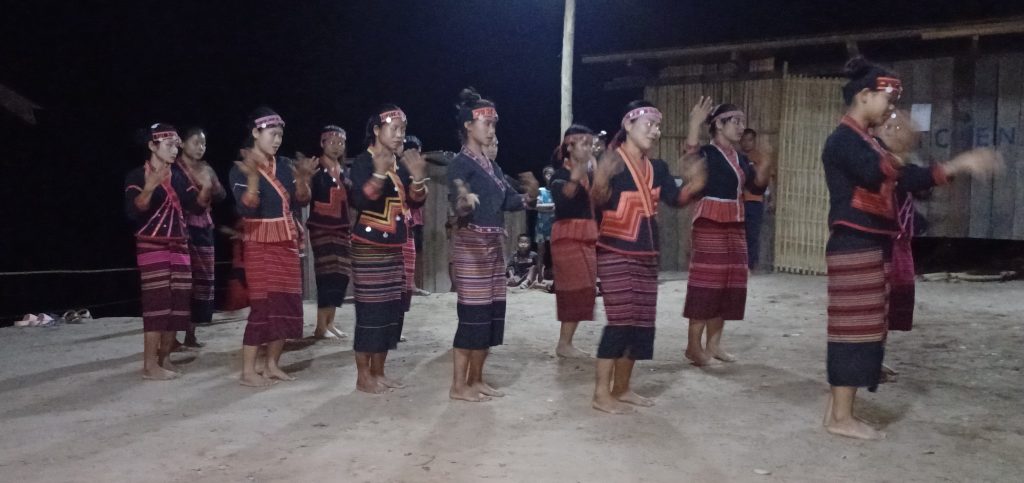
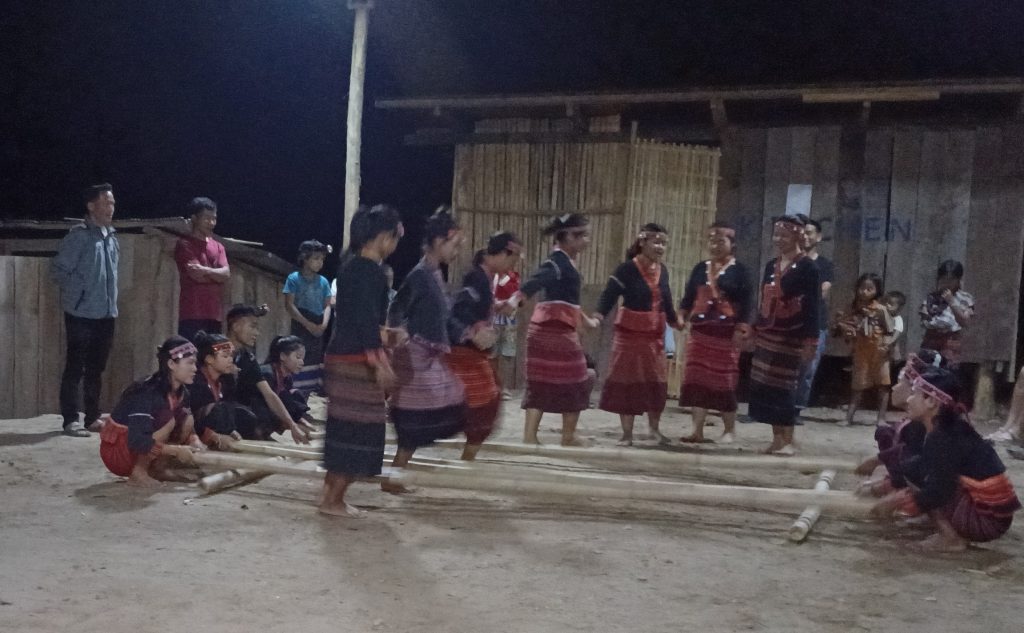
Entertainment over, we depart up the slope shining our phone torches en route to our various houses. I take advantage of the outside toilet before entering my abode. Then take off shoes, as is usual practice, and climb steepish wooden stairs to find my ‘bed’, a thin mattress on a rattan mat with one blanket protected by a mosquito net. Four identical beds lie side by side. Not exactly 5 star. Bare light bulbs are strung on worn wires and attached by crocodile clips to the ceiling of the accommodation. Don’t sleep well. Possibly because I have to venture outside to the tempting toilet and I wait far too long before finally forcing myself to get out to answer this call of nature. I had drunk a lot of water, as one should.
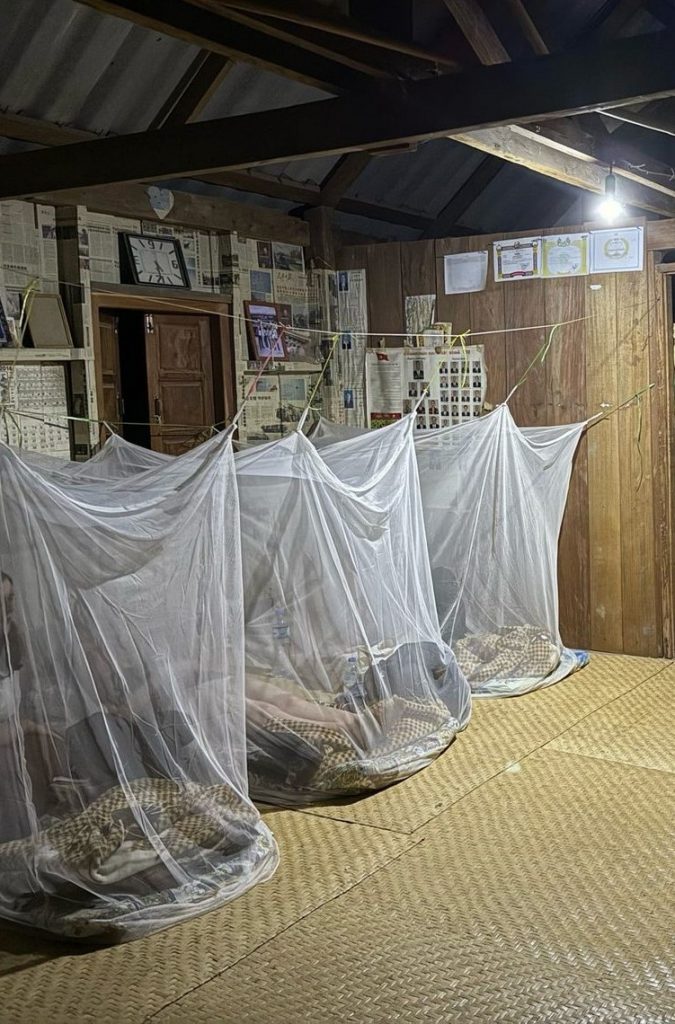
Anyway, it is a tricky manoeuvre. Try not to disturb people each side of my mozzy net. Head past slumbering bodies, step softly down the steep stairs, pass more slumbering bodies, lift the catch of the door and exit into the dark night. There is a dog on the doorstep. Roosters are crowing, babies crying, women nurturing and sounds of sleeping people. And the flowing river. Quite magical really. If you enjoy this sort of thing.
Breakfast in the community hut. Omelettes and rice, bananas and 3 in 1 coffee – you know – those plastic sachet things with the coffee, milk and sugar in one. Too bad if you don’t like sweet coffee. Take it or leave it. Birds are twittering, ducks, hens and dogs are running about, coconut and mango trees shade pathways. Wonder how the villagers make their living. The guide tells us that the main crops they grow here are hops, corn and rice. Supplemented with gold panning, fishing and taking tourists on slow boats, I guess.
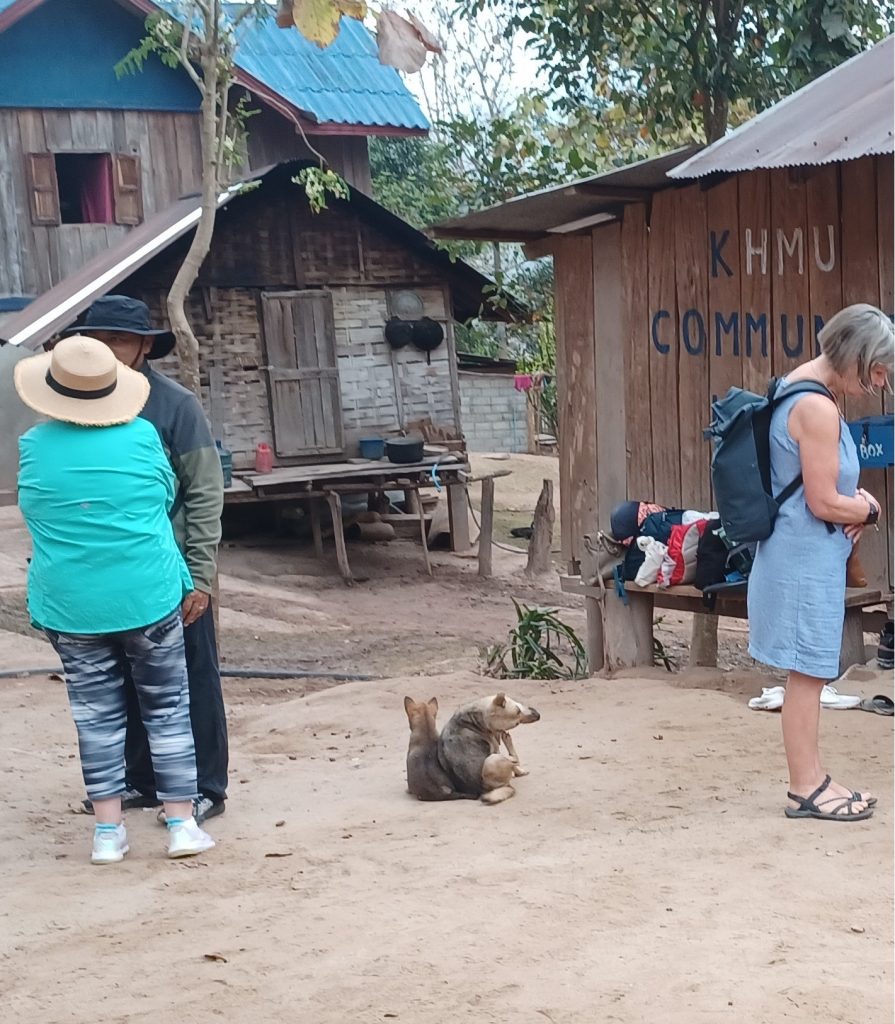
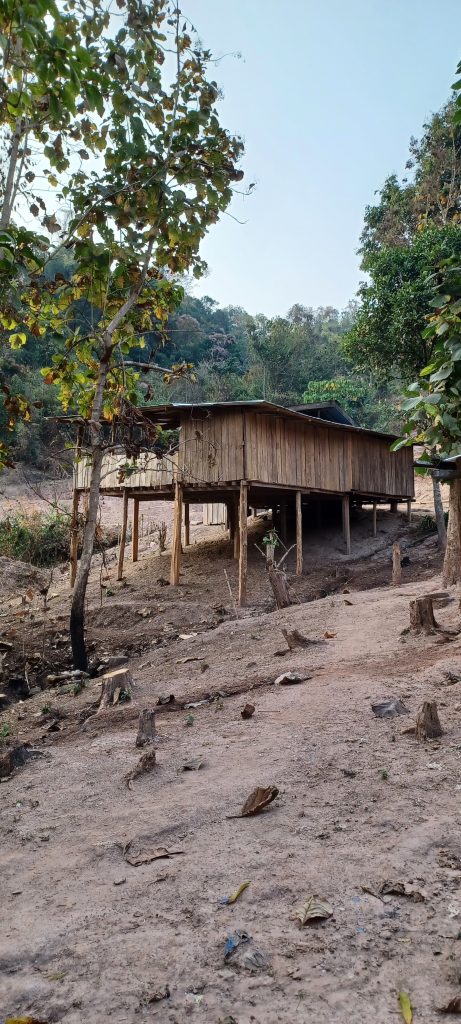
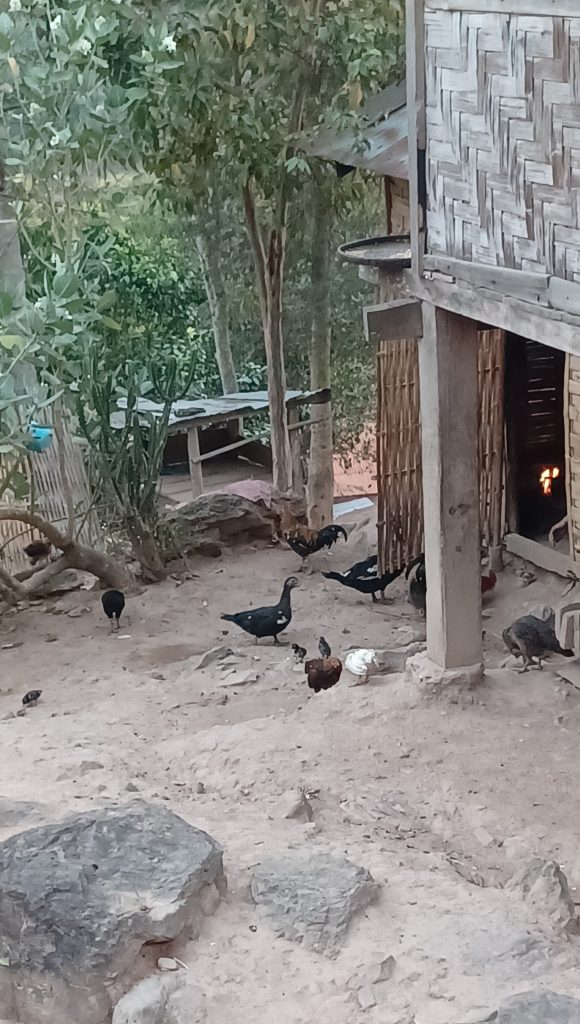
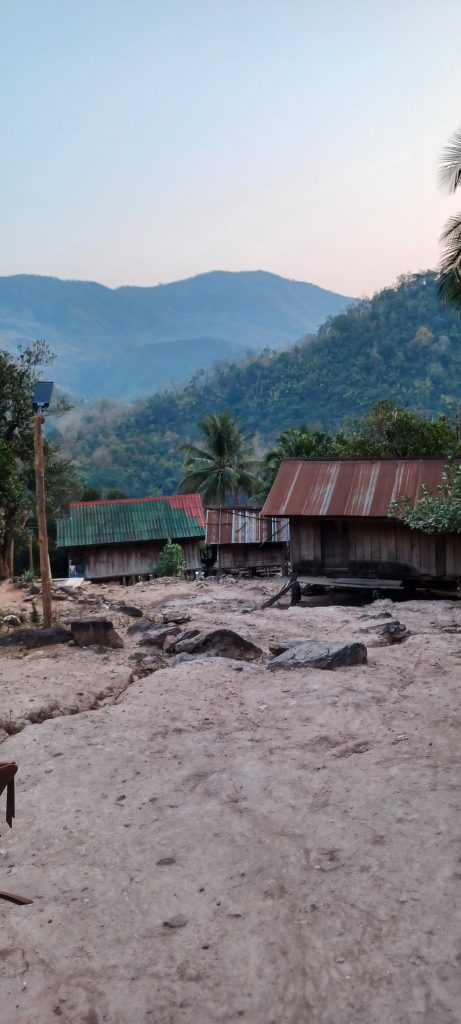
After breakfast we assemble outside the community hut, thank our hosts and their dogs and head down the leafy track towards the Mekong. And the mist hangs over the forest and our river boat awaits us in the stream.
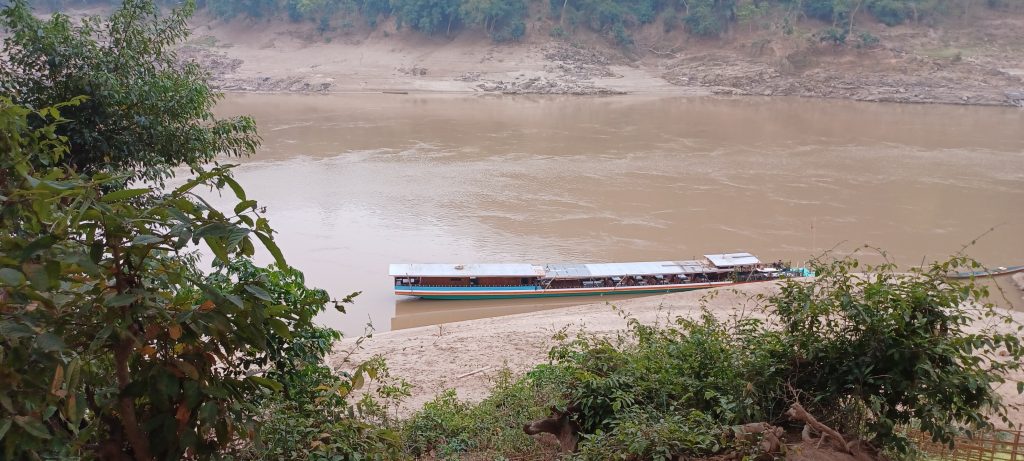
There is a fresh breeze this morning. I actually don a track suit top for a while. Laze on a sunbed on the foredeck until the need for coffee sends me into the boat’s inner sanctum. Return to the foredeck and watch the low clouds on the mountains, sun just gleaming through at 0730. Fabulous. And the ever present rocks and oxen and forests slip by.
Pak Ou Cave
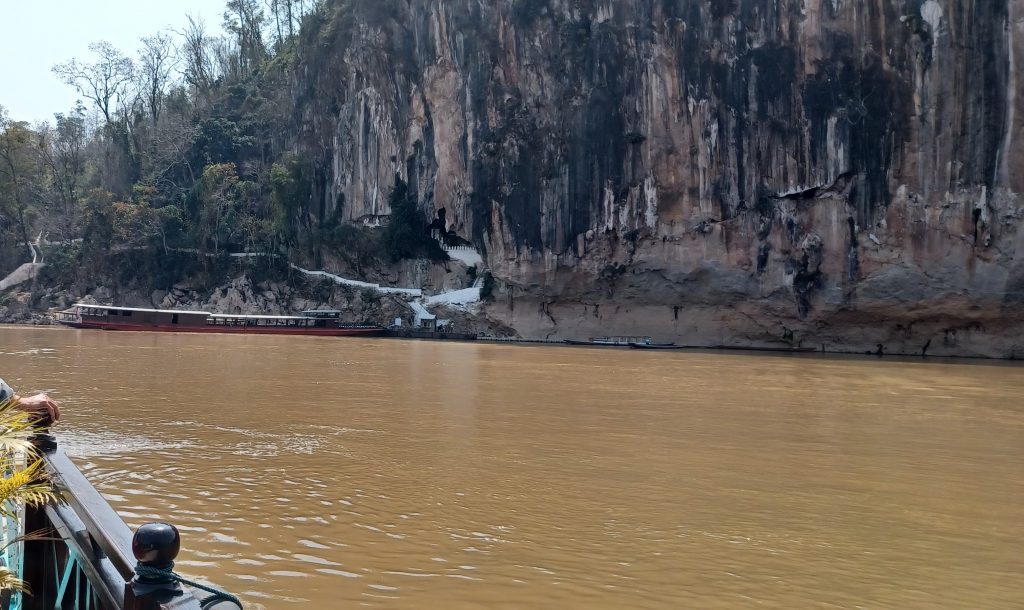
Late afternoon we approach the Pak Ou Cave, where the Mekong and the Ou rivers converge, to view the 4000 Buddhas left in this cave complex by worshippers. White bright steps to the lower and upper caves are visible plus a few other boats that got here first.
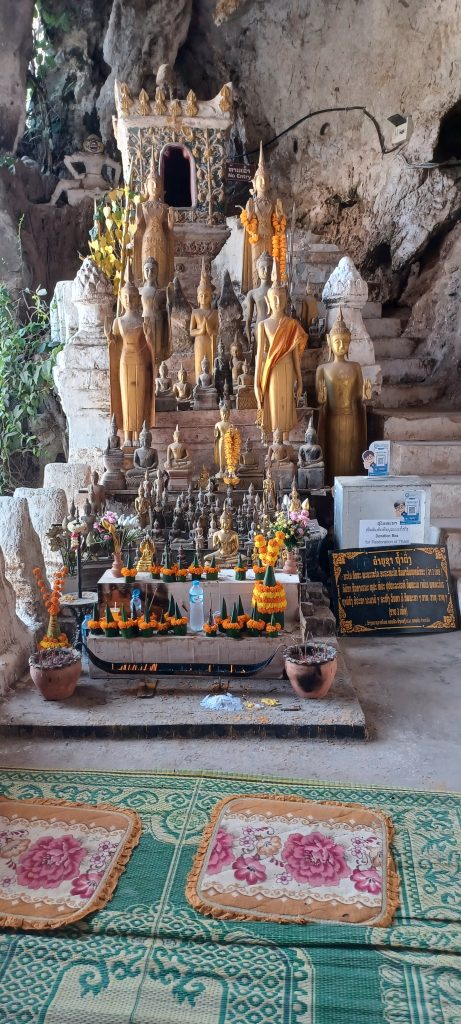
We ascend the flights of white steps to view the lower cave. The Buddha used to reside here, according to folklore, and there seems to be a shape of a Buddha in the rock. The locals made the statues to honour him. The Buddhas are all shapes and sizes, some wooden, some made of resin, covered with lacquer and gold leaf – which kept all those gold diggers busy sluicing. Some of them guard the main Buddha, which always has a flame on its head as I was told in Thailand (see Thailand, part 1: Bangkok). The Buddha is shown in three common poses according to the information given. Call for rain is shown by arms pointing down; calling earth to witness is depicted by a seated figure with right hand extended downwards, left on the lap; and the meditation pose is of a seated figure with hands crossed.
Sufficiently energetic, I ascend to the upper caves 278 steps up. These caves were first used for religious purposes when the people worshipped ‘Phi’ or the spirits of nature, according to a notice. Buddhism spread much later and in the 16th century the kings of Laos adopted Buddhism. The King apparently, up until 1973, used to make a pilgrimage to the caves for the New Year.
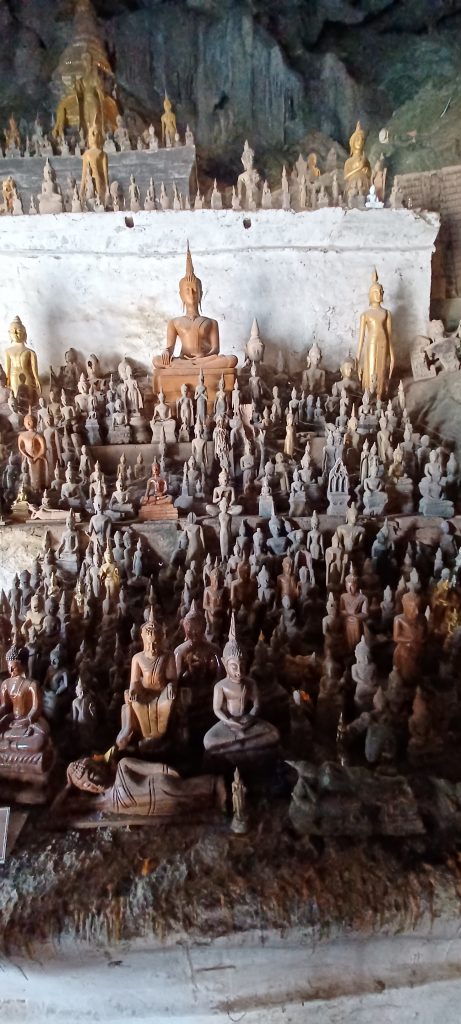
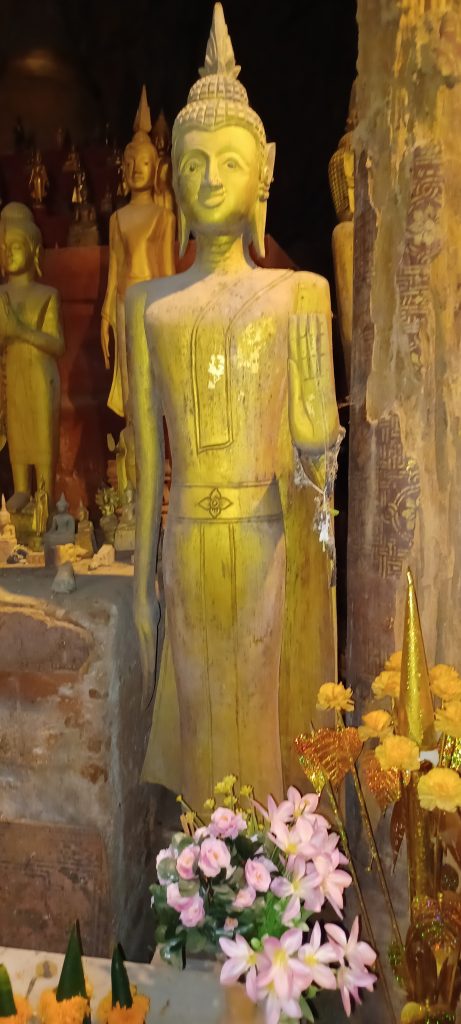
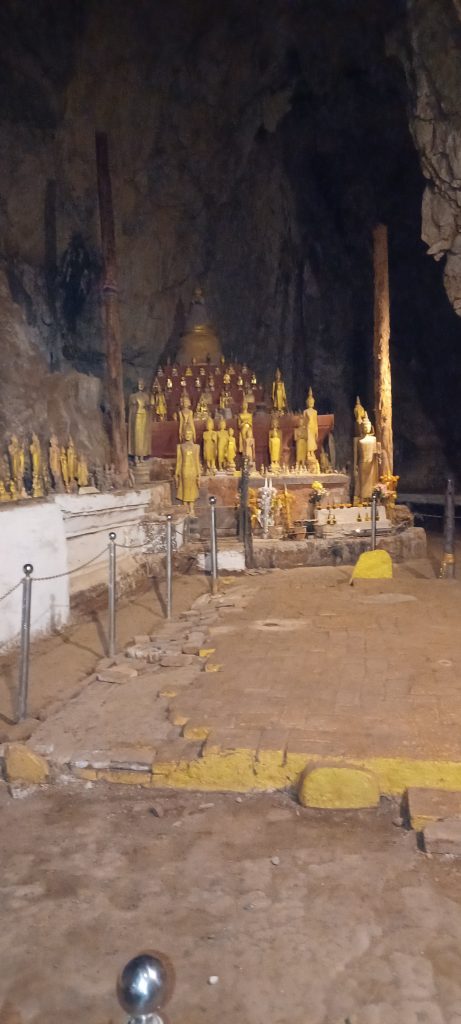
Slowly descend the white steps. More boats are approaching the pontoons to drop off sightseers. We file aboard our vessel and cast off once more. Feeling a trifle peckish after all that Buddha gazing and head for the refreshments.
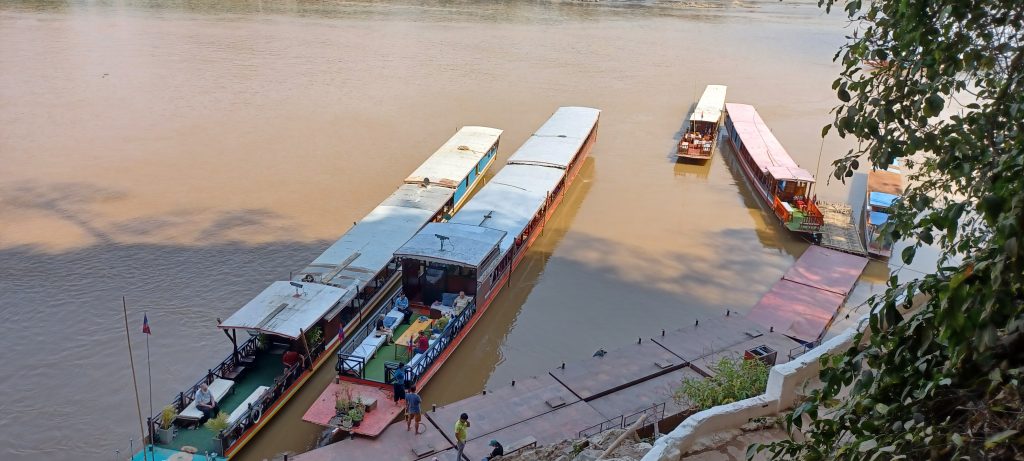
It is a short distance from the cave to the disembarkation point and the end of our Mekong River cruise. Ruefully, disembark from our lovely boat and are driven off in long wheel base land-rovers, all of us sitting uncomfortably in the back in two rows facing inwards, to a hotel. Bit more sophisticated than the home stay I suppose. Take a shower.
Traditional Arts and Ethnology Centre (TAEC)
The long wheel base land-rovers pick up the group next day. A visit to the Traditional Arts and Ethnology Centre (TAEC), housed in an old French house, the onetime residence of a colonial judge, is first on the agenda. Interesting displays within of costumes and cultural artefacts of the Khmu (or Kmhmu). These people are considered the original inhabitants of Laos, who moved to the Lao uplands when the Thai people settled the lowlands during the first millennium, according to an information board. They are the largest ethnic minority group in Laos. There are three main tribes in the country and a small Sino/Lao community on the Chinese border, I gather. On display are examples of the Khmu people’s traditional dress including that worn by the dancing girls in Ban Huay Thom village. Also items of basketry, which is made from bamboo and rattan, weaving looms and the resulting woven textiles.
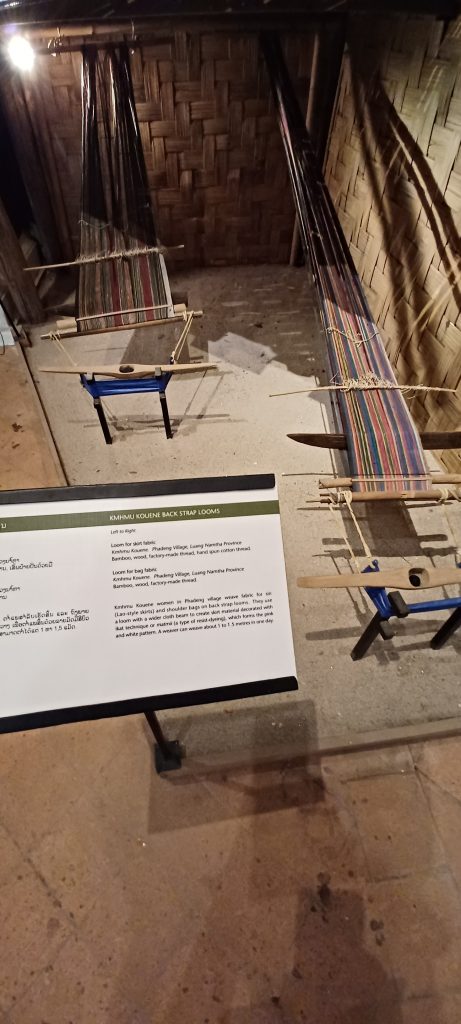
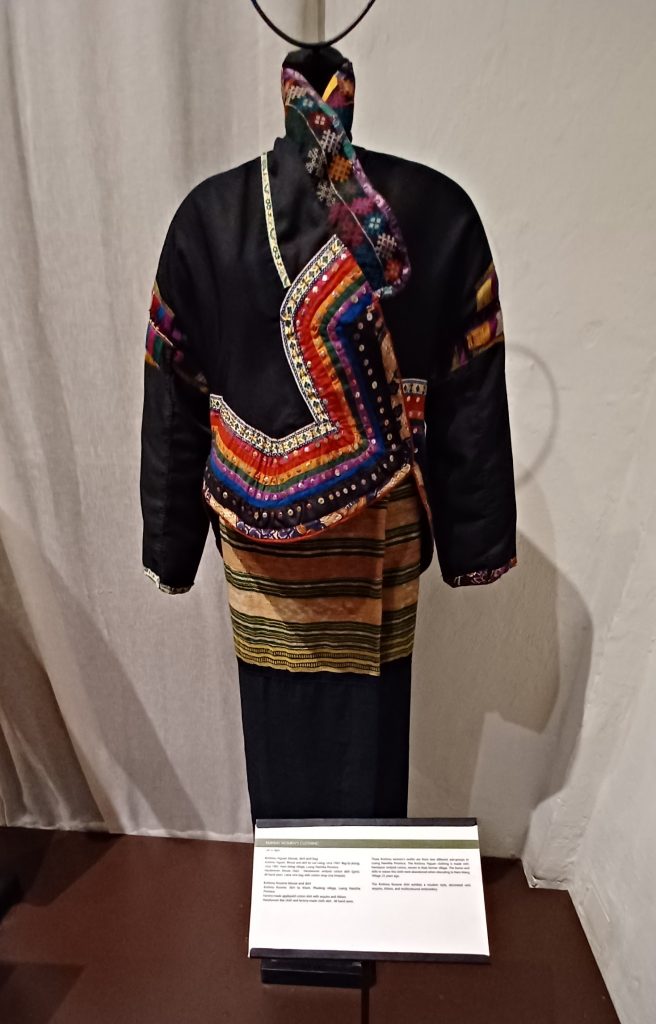
Ock Pop Tok (East meets West) living crafts centre.
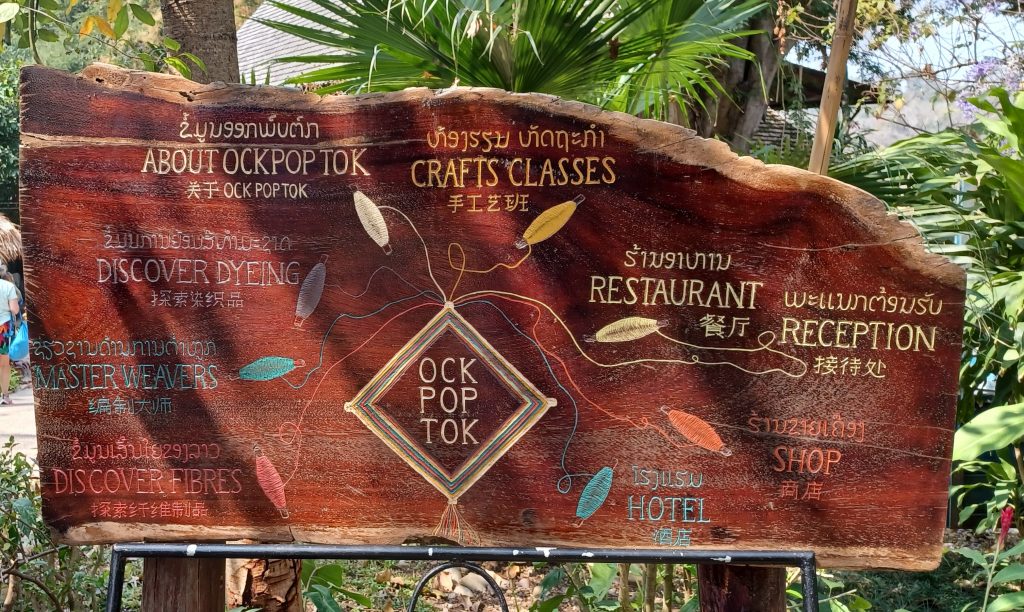
Thence to a craft centre, the Ock Pop Tok. Located in a congenial spot on the Mekong’s luscious banks. Craftsmen and women are making all sorts of textiles, including woven fabrics and batik. I wander in the direction of some strings of dyed silk. In front are samples of the plants used for creating the dyes and, close by, silk worms on mulberry leaves and their yellow and white cocoons. The white is better, according to our guide, as it can be dyed more easily than the yellow colour. Further on, trainees are making wax patterns on cloth, adding the dye on top. When put in boiling water the wax melts and the dye remains, resulting in batik.
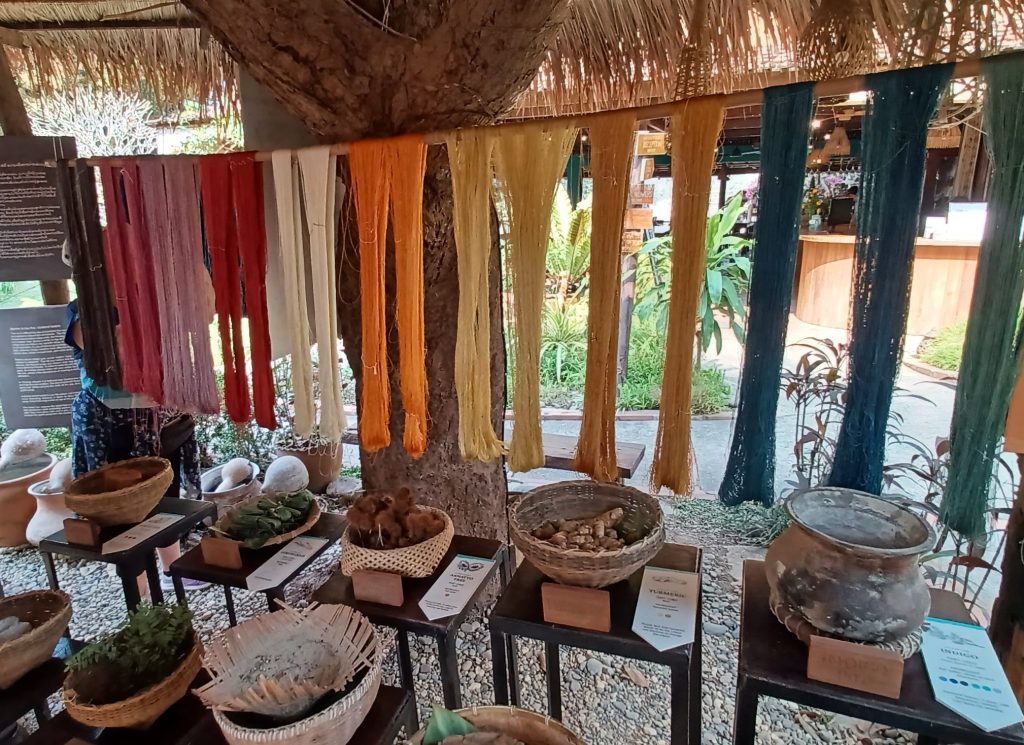
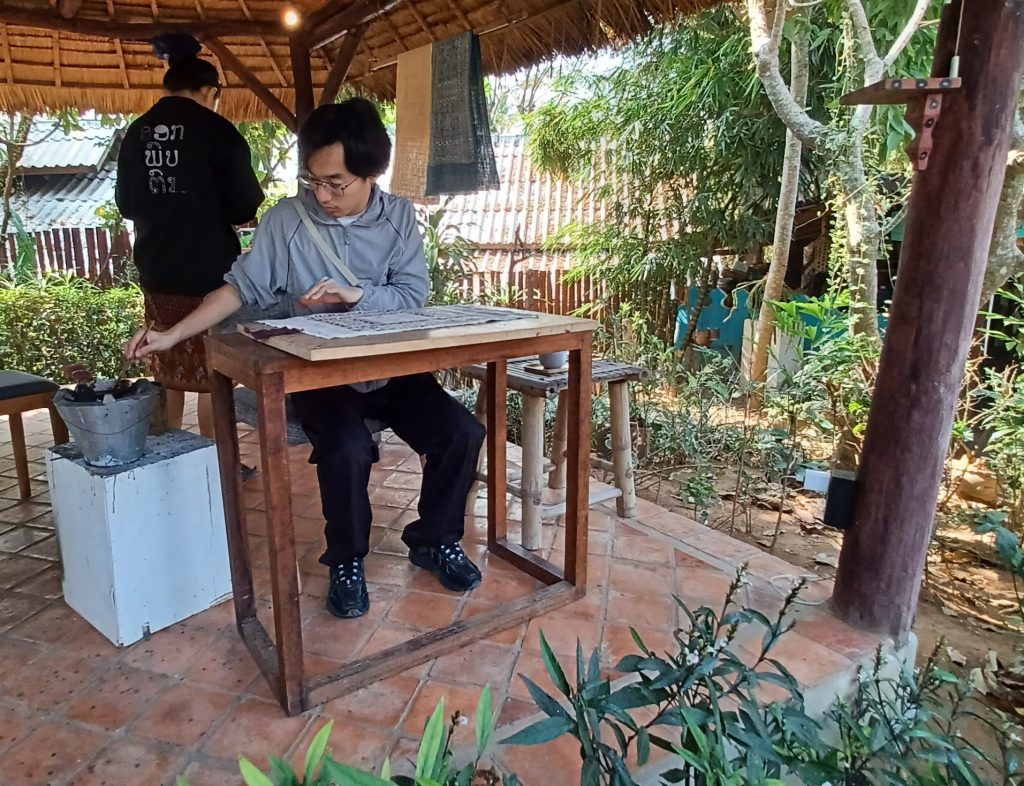
Amble along to read some info about bamboo. A flexible plant this is with a tensile strength greater than steel. Who knew. Further information about hemp and how sustainable it is and better than anything else for carbon storage. OK. All very fascinating and brain enhancing. Amongst the foliage hangs a large map, which I peruse. This depicts the silk road trade route between east and west in 400 AD. And, of course, there is an enticing shop selling handicrafts. More alluring still a splendid café overlooking the Mekong, placid and unruffled. There to lounge a while before heading off to today’s highlight.
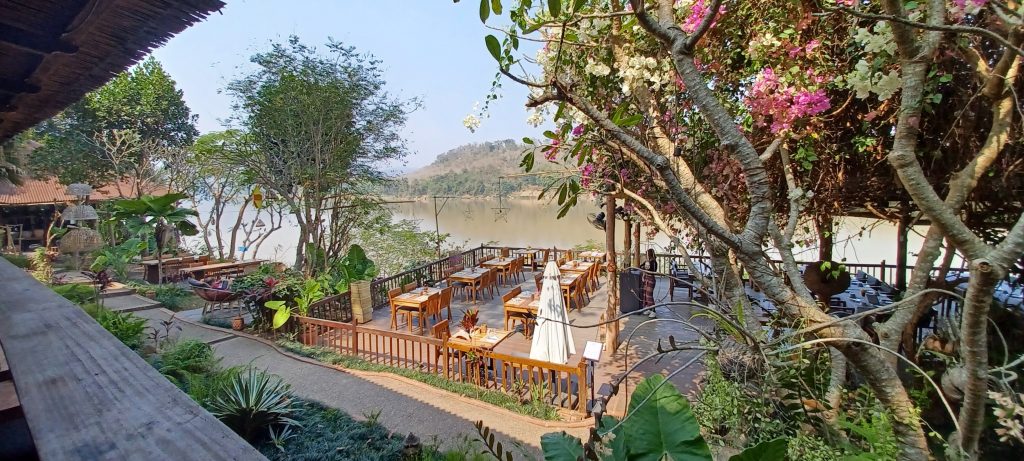
Kuang Si Waterfalls
The last stop before the world heritage site of Luang Prabang is at the Kuang Si waterfalls. The land-rovers with occupants arrive at Ban Tad village and we all pile out. All sorts of merchandise is laid out for sale on myriad stalls all over the place. Tourists in shorts or baggy leggings and tee-shirts hover in front of them. A lady wields a machete to chop the top off a coconut before handing it over to an eager looking chap, who holds said coconut up to his mouth and swills down the milk with gusto. Chickens roast; bundles of sticky rice wrapped in banana leaves are arrayed alongside what looks like skewered boiled eggs, chunks of meat on sticks, large sausages, piles of coconuts, mangos, melons, sugar cane. Atmospheric sort of place. Scent of trees, roasting meat and sweaty armpits.
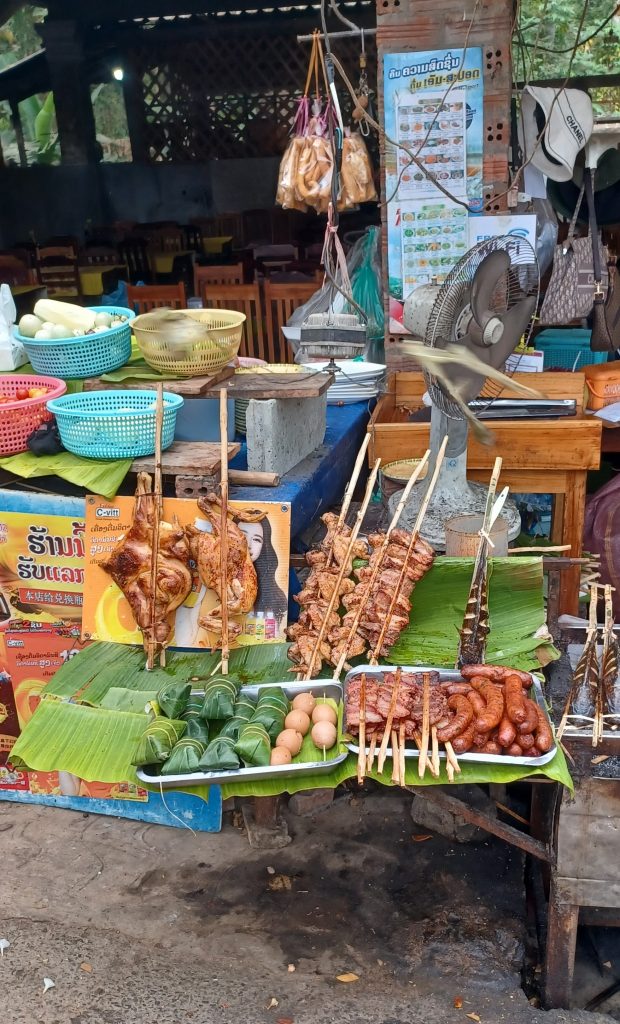
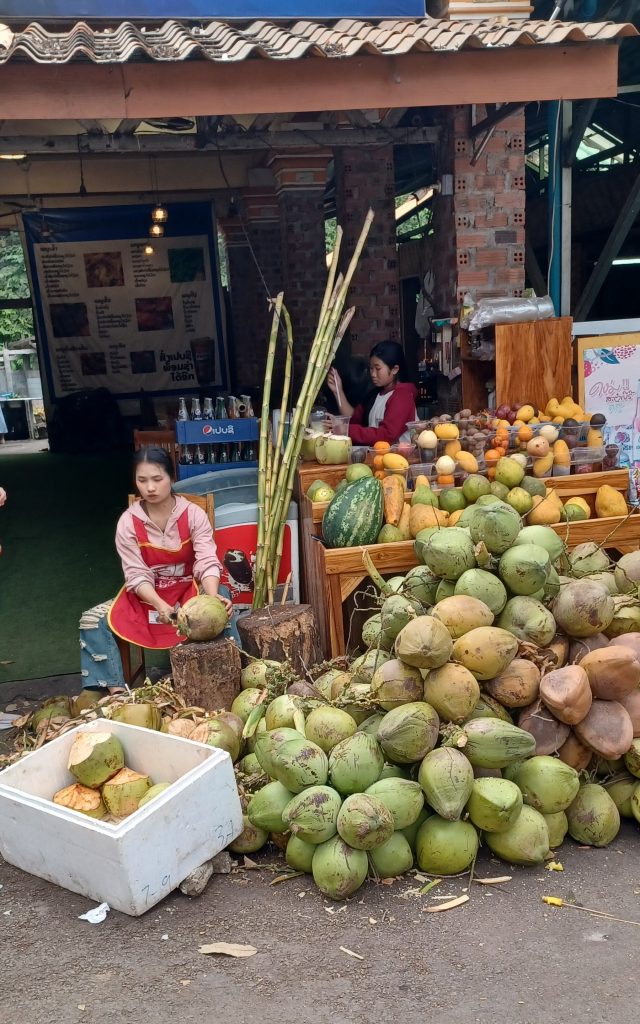
Drift through the stalls before hiking up a steepish hill. Here we find prettyish waterfalls, into which the Si river flows, in three tiers tumbling down into turquoise pools. A bridge sited in front enables visitors to take photographs up close. Some of our group don bathing suits and go for a dip. Not me. Watch two of them swishing about in a milky pool, water gently lapping round them, with background of foliage. Were it not for all the other people, this could be a peaceful, dreamy sort of place in which to ponder.
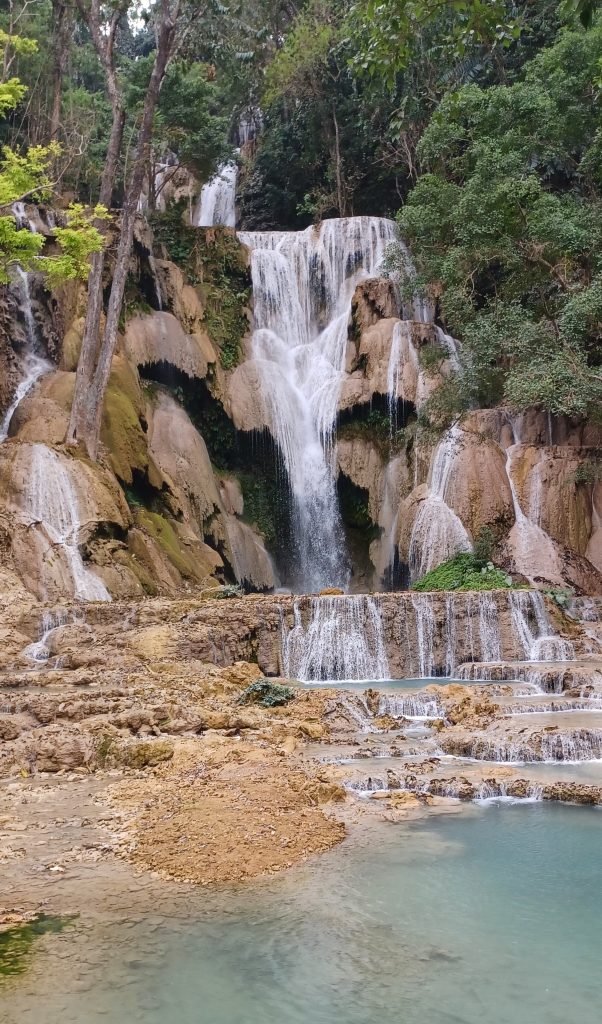
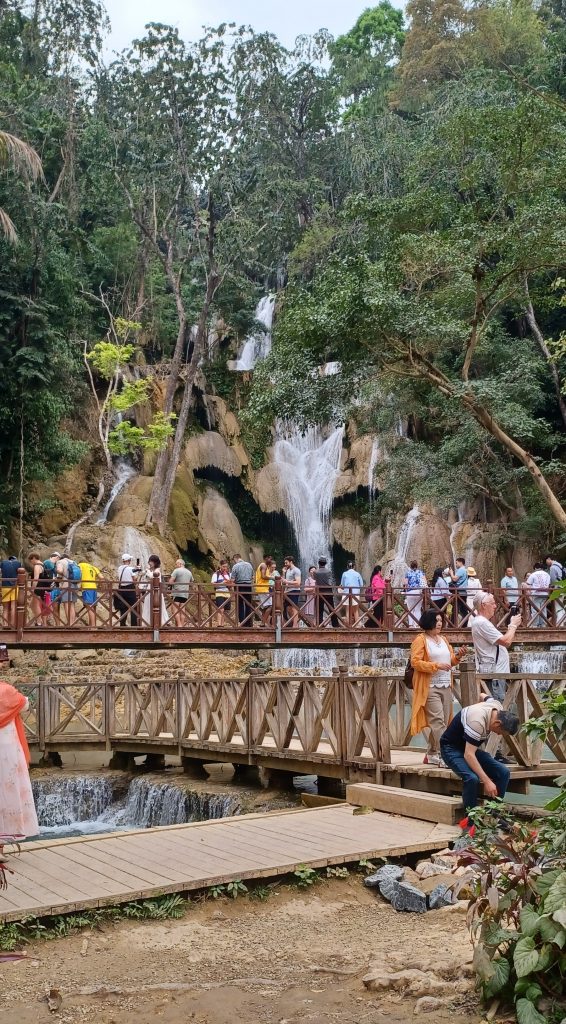
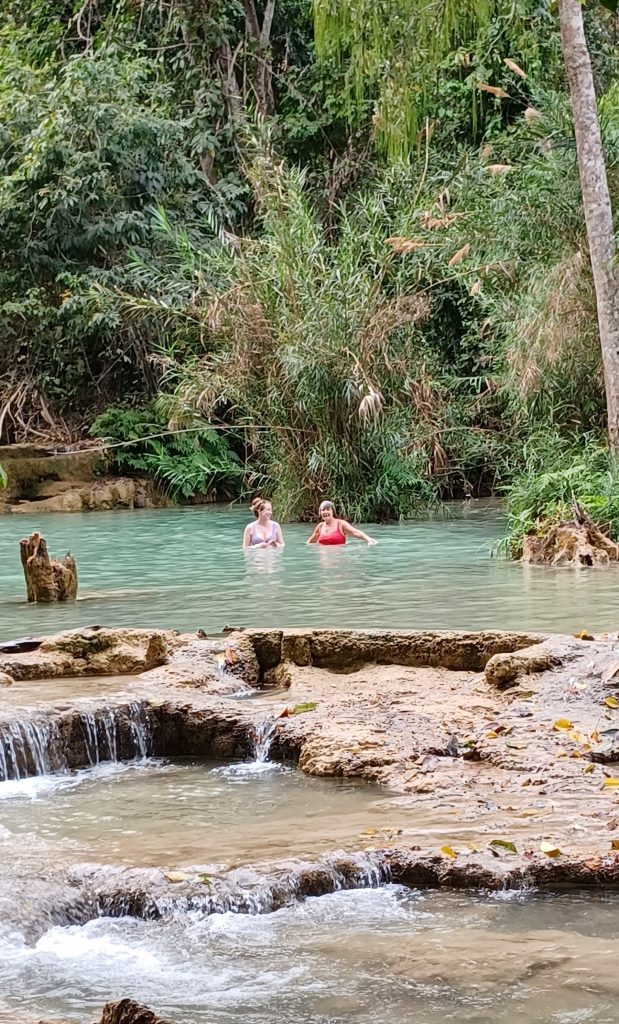
On the way down a track to the village are a number of sacred Moon Bears, or Asiatic Black Bears, within a fenced off area. It is a Moon Bear rescue and conservation centre. Moon Bears, also Sun Bears, are hunted illegally in Laos and kept on farms to harvest their bile. Taken from their gall bladders with a syringe apparently, a cruel practice, which can cause long term suffering and infections. Bile is used in Asian traditional medicine. An organisation called Free the Bears is trying to help the bears and requests tourists to buy T shirts or make a donation to help fund their keep.
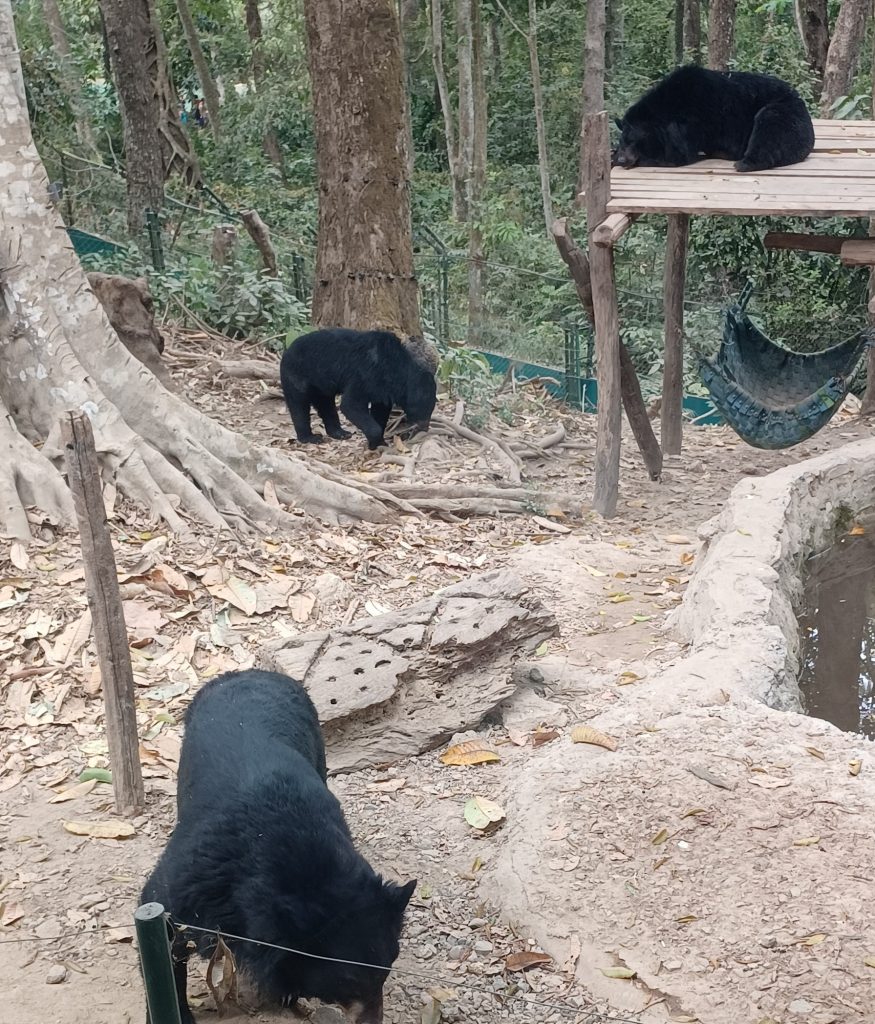
Leaving the moon bears to frolic in their sanctuary, we descend to where our transport awaits and head to our hotel in Luang Prabang for the night.

Leave a Reply